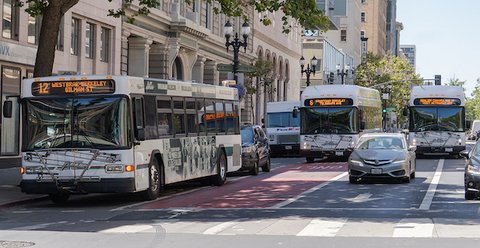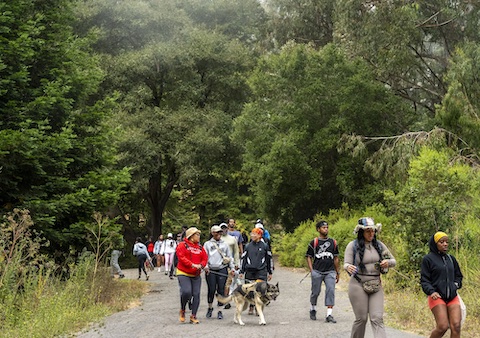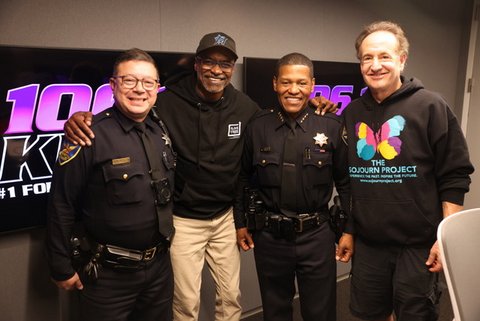
11 Aug Bay Area Transit Agencies Say Bye-Bye to Long Transfers, Prepare to Get in Sync

Several Alameda-Contra Costa Transit District buses in downtown Oakland on Aug. 8. Several bus and rail public transit agencies are rolling out a coordinate effort to facilitate transfers and scheduling. (Andres Jimenez Larios / Bay City News)
By Andres Jimenez Larios
Bay City News
Easier transfers and changes to schedules beginning on Sunday is music to the ears of Bay Area travelers after a coordinated effort between bus and rail public transit operators results in the Big Sync initiative.
Across the Bay Area’s nine counties, transportation agencies are rolling out new coordinated changes to their schedules, dubbed the Big Sync, that they hope will allow for smoother transfers between services for more passengers.
The decision to undergo months of planning between some of the region’s largest operators like BART, Alameda-Contra Costa Transit, Muni, SamTrans, and Caltrain was seen as necessary so more people would elect to take public transit and address the budget deficit many of these operators are facing.
The transportation education and awareness nonprofit Seamless Bay Area conducted a series of workshops with communities across the Bay Area and found one of the biggest frustrations among passengers is the lack of coordination between agencies.
According to the organization, people complained they were waiting for extended periods of time at stops when they were transferring between agencies, for example.
The Metropolitan Transportation Commission, the transportation planning agency for the nine-county Bay Area, created a Transit Transformation Action Plan and began to work with local public transit operators on ways to address the concerns of the public as well as the needs of each agency.
Agencies already facilitate timed transfers within their own systems, such as separate BART lines meeting at MacArthur station or SamTrans routes around their transit hubs, but the purpose of the Big Sync is getting coordinated services between different agencies. Operators shared rider data and patterns to create optimal pairings between their agencies.
The agencies are hoping a passenger traveling across agencies will have a better experience after buses and trains are timed to meet each other at certain key stops.
“These are examples of how Bay Area transit agencies are acting as one network to better serve the Bay Area to help reduce traffic and improve the quality of service,” said BART spokesperson Alicia Trost. “Making transit faster than driving a car and easier to navigate is possible when the Bay Area invests in transit and we all work together.”
“Caltrain continues to work and meet with BART, VTA, and SamTrans to improve transfers. By sharing data and rider patterns with our partners, we were able to collaboratively sync up several routes that connect at the Palo Alto Transit Center and Caltrain Station, greatly reducing travel times,” said Dan Lieberman, spokesman for SamTrans and Caltrain. “Because of that, ideal transfer connections have jumped from 44 to 146 and those that were too long or too short have dropped from 106 to just a couple dozen.”
Public transit operators are incentivized to make their service more attractive for more people because of the major budget deficits they face. Their situation was made even more dire by the expiration of federal emergency grants provided during the COVID-19 pandemic and a slow return to pre-pandemic ridership numbers.
The MTC conducted an analysis on budget shortfalls and the outlook of operations in the region and found Bay Area operators could face a $3.7 billion deficit by fiscal year 2030.
Efforts such as the proposal of a new regional measure for a sales tax across five Bay Area counties and a new transit pass program between operators and entities have appeared as part of a collective effort to diverse funding sources.
Ultimately, riders are finding the news of a better and more seamless experience welcoming.
Oakland-based artist Jason Brown said he was excited to get to his destinations quicker.
“When I am at a stop after BART and I am waiting for a bus, it feels like a long time,” said Brown. “I look at my phone and I am waiting and waiting and waiting for what feels like forever.”
San Francisco State University students Jessica Yang and Nancy Lee said their trips across the Bay will be made easier. They commute from Oakland to school using their school-provided transit pass and said they need to make several transfers between agencies to get to their destinations.
Even visitors to the region are delighted transit is going to be made easier for them. Johnae Henderson from Rialto in Southern California was boarding a ferry to San Francisco from Oakland and expected to continue using public transit around the city.
“My kids don’t know public transit. They only know how to get around on Lyft and Uber,” said Henderson. “I think making it easier for people like us who are just visiting is great. It makes the experience more fun.”
Details about the changes of individual lines, the schedules, and optimized ideal connection points can be found on the websites of the respective agencies. BART has a trip planning tool that is being updated to facilitate and note accurately the new changes starting Monday.
Copyright © 2025 Bay City News, Inc. All rights reserved. Republication, rebroadcast or redistribution without the express written consent of Bay City News, Inc. is prohibited. Bay City News is a 24/7 news service covering the greater Bay Area.






No Comments